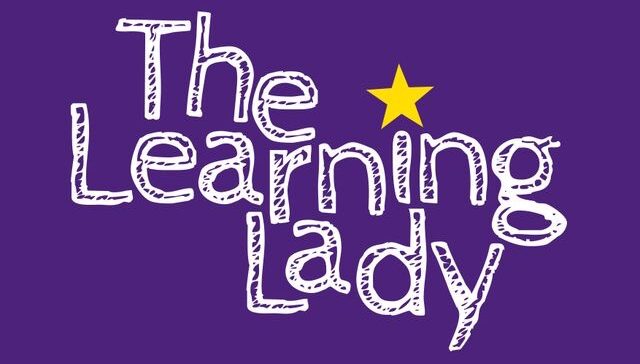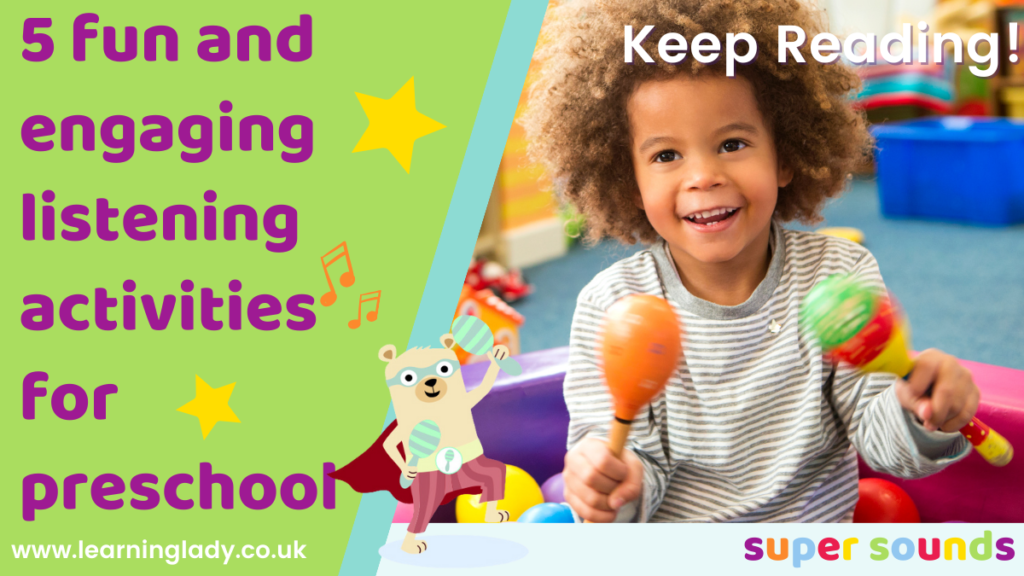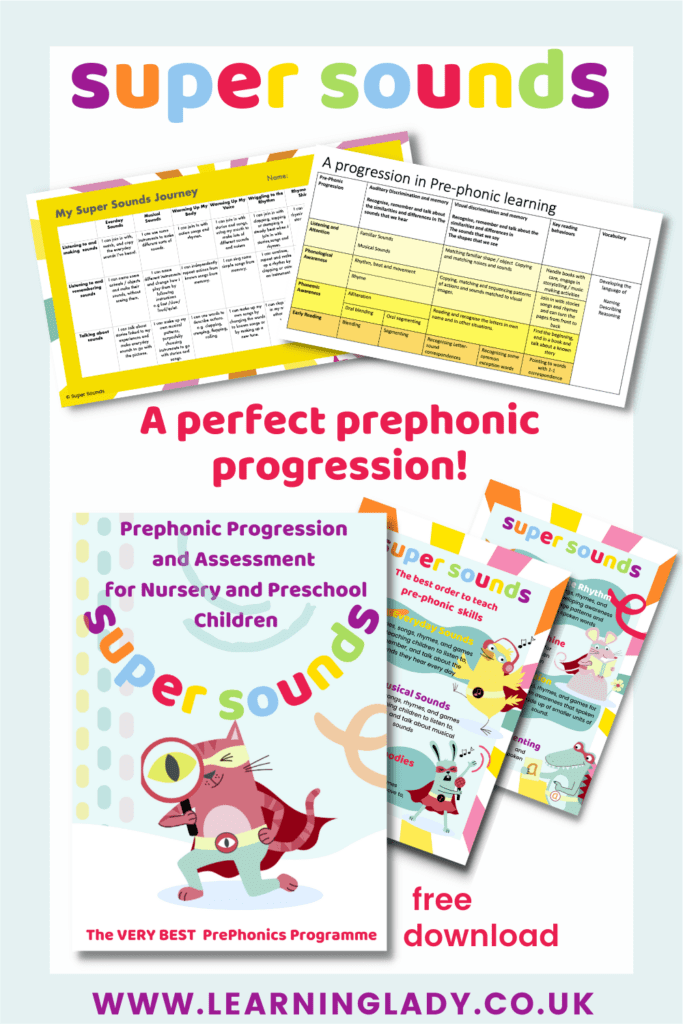In our Nursery, we knew that listening activities for preschool are the bedrock of effective phonics teaching. These were a priority for our 2 and 3 year olds. This is a key pre-reading ingredient because phonics is a sounds-based system that matches spoken sounds to letters. We needed our preschoolers to be ready for the challenging journey ahead. |
Listening games make the world of difference to reading
Listening games that help 2, 3 and 4-year-olds to hear similarities and differences in everyday sounds are crucial to this development. So, we developed some super simple and fun listening games that our preschoolers loved. This is our story…. |
Listening to sounds everyday
In a noisy world, attention and listening games for early years children have never been more important.
These help little learners to isolate and compare all kinds of differences and similarities in sounds.
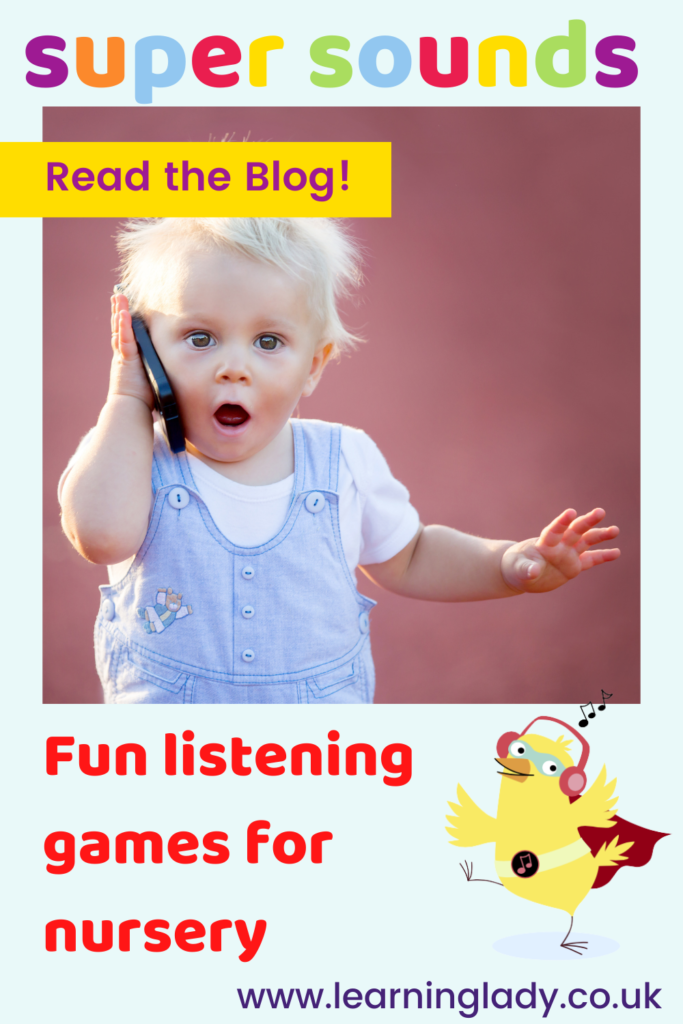
This prepares them for isolating and comparing abstract letter sounds later.
Preschool listening games develop prephonic skills
Preschool listening games need to develop 2 key concepts ready for reading.
- An awareness of the difference between loud sounds and quiet sounds
- An awareness of the difference between fast and slow sounds
The difference between sounds matched to letters in the phonetic alphabet can be subtle, but underpinned by these simple ideas.
Loud and quiet sounds

In the English phonetic alphabet, the voice is used to say some sounds, and not others.
Sounds like ‘a’ use the voice and shape of the mouth to articulate the sound.
Sounds like ‘p’ are unvoiced. The sounds is created by the lips and control of breath, rather than the voice box itself.
Attention and Listening games for Early Years
Attention and listening games for early years provide a bridge to hearing the similarities and differences in letter sounds.
Here are some super simple ideas we used initially to introduce louder sounds in everyday play with our 2-, 3- and 4-year-olds:
- Talking loudly like a giant
- Stamping around outside
- Banging a drum as hard as possible
We enjoyed building an awareness of quieter sounds in Nursery by:
- Whispering messages and playing whispering games
- Tiptoeing quietly
- Tapping a drum gently
Fast and slow sounds
Some spoken sounds like ‘s’ are long and stretchy. These are slow sounds.
Other spoken sounds like this include: z, m, f, n, r, v, sh
Some spoken sounds like ‘i’ are short and bouncy. These are fast sounds: b, c, d, g, j, o, ch
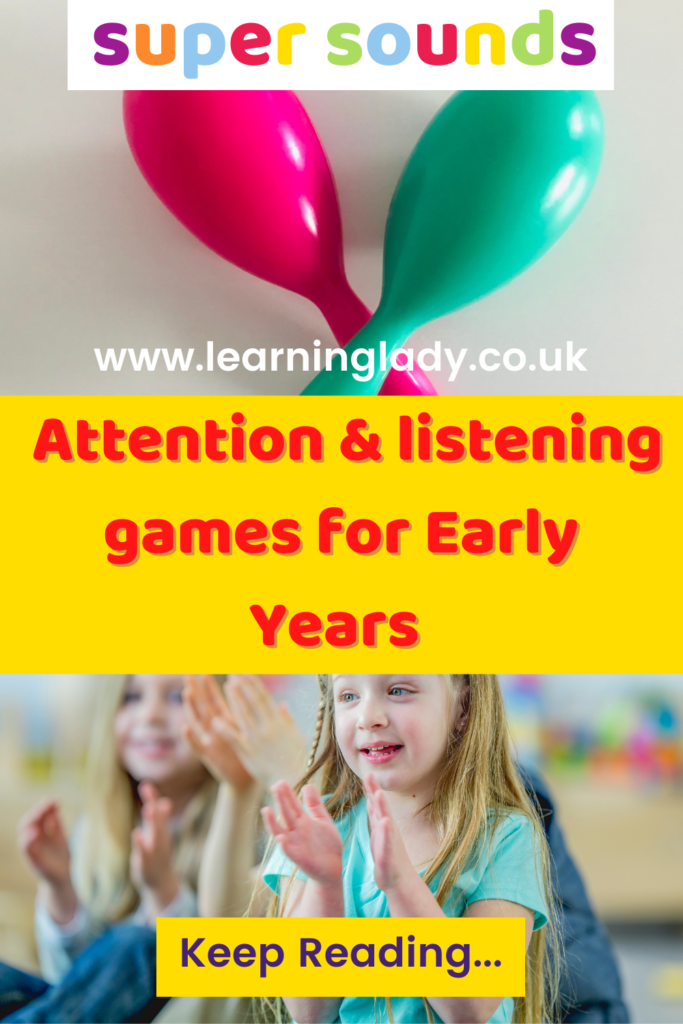
With lots of practise, our 2- and 3-year-olds became super successful at understanding the differences in sound speed.
Some easy peasy preschool attention and listening games that really helped included:
- Clapping pattern games
- Music and movement games
- Playing musical instruments in different ways
Listening games for 3-year-olds develop vocabulary too!
Like many other nursery settings, our children often began their preschool journey with a limited vocabulary.
Listening games for 3 year olds were the perfect way to improve spoken language by modelling how to describe different types of sound.
We made a conscious effort to model universal concept words like loud, quiet, fast, or slow during our prephonics games and beyond.
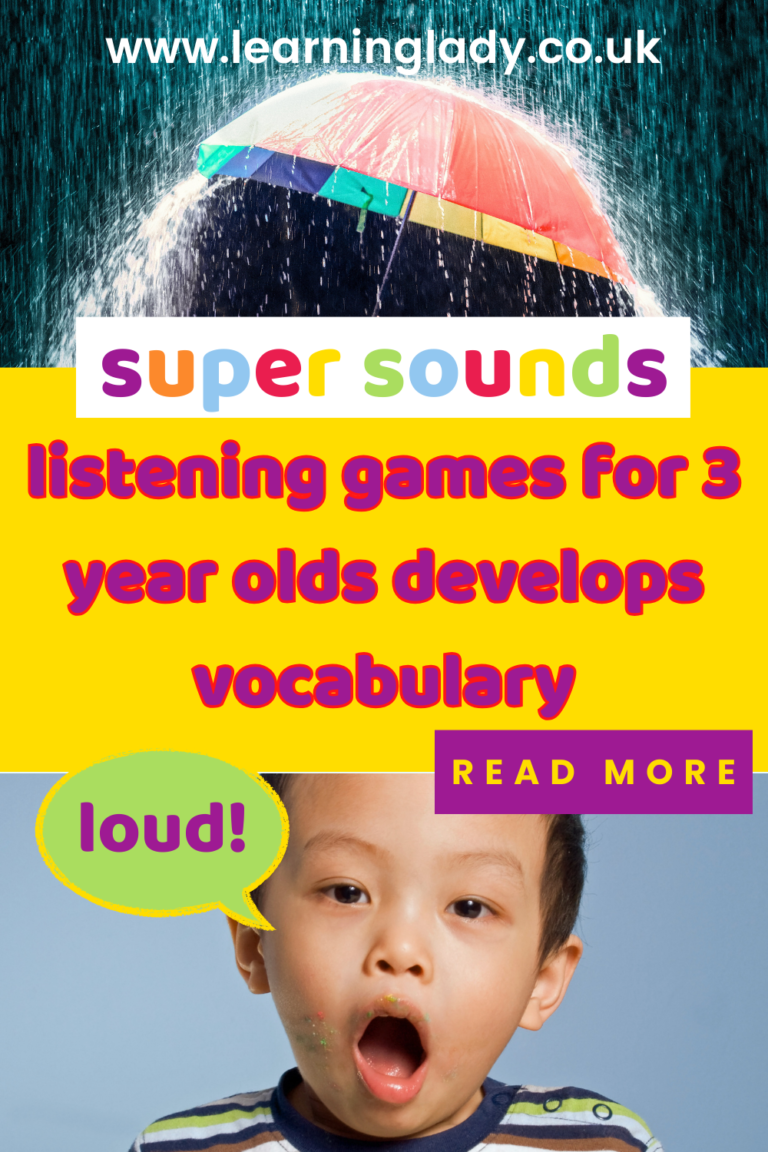
Describing sounds
Overtime, preschoolers began to use this conceptual vocabulary during all kinds of play and learning situations.
We noticed that 2 and 3 year olds were much better equipped to explain their thinking and articulate choices using the new words they had acquired.
Some of our experienced practitioners had previously used Letters and Sounds Phase 1 to develop sound awareness and vocabulary. And this was a great starting point for our work.
Phase 1 listening games for 2 and 3 year olds
To find out more about how phase 1 listening games can help your 2- and 3-year-olds, this super speedy explainer video is the perfect place to start.
Which children need preschool listening activities?
We recognised an initial challenge when we started thinking about preschool listening activities.
Some of our 3-year-olds already had well-developed listening skills, and others were at the beginning of their journey.
We needed a way to stretch the vocabulary and verbal reasoning for some preschoolers while working on basic sound differences with others.
We set about finding a super simple solution for mixed ability group games that all of the children could benefit from.
Instant sound success
We found this instant assessment tool invaluable!
It helped us to instantly pinpoint where each of the children needed to start, by identifying what they could do first.
This made it really easy to adapt the preschool listening games ‘on the spot’
Listening game Phase 1 top tips
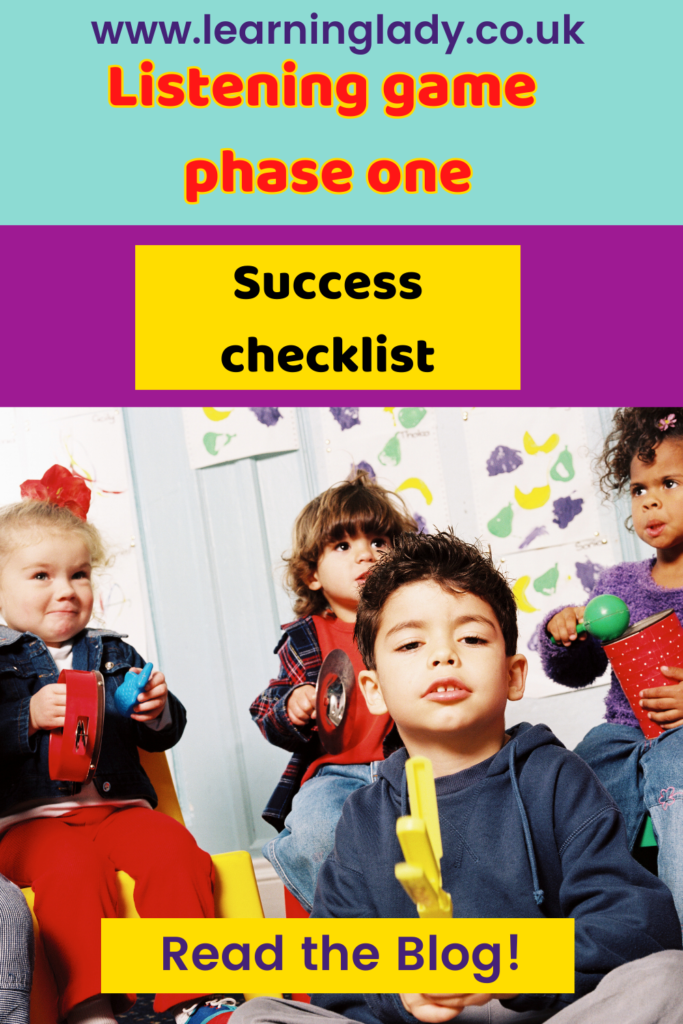
Every time we played a listening game phase 1, we needed to set the children up for success. This meant creating an environment that was optimised for effective listening, free from as much alternative stimulation as possible. |
A listening environment checklist
- Declutter to create a visually distraction free space.
- Remove external noise as much as possible by shutting the door to a smaller space.
- Set the expectations for listening time so children know what good listening looks like..
- Begin playing games with familiar sounds.
- Play with big sound differences first, becoming more similar over time.
The best listening games early years children need
Here are the listening games early years essentials we played from the Super Sounds prephonics programme. Our preschoolers loved playing these over and over again and we hope yours will too! Whether you’re at home with toddlers, or working in a preschool setting, these super simple games are perfect. |
Listening Activities for Preschool |
The Drummer's in the Ring
All you need for this preschool listening game is a drum or something to bang! At our Nursery, we had a curtain for the drummer to hide behind so we couldn’t see them play. This added to the excitement, and the other children couldn’t wait to be drummers too! |
Listening Activities for Preschool | Musical Hide and Seek
This fun listening game for 3- and 4-year-olds is like a traditional game of hide and seek. It’s the kind of game that’s easy to play at home and it’s easy to vary the sound clues. In our Nursery our first clues were clapping quickly, then fast and slow. The children loved it most when we used music and changed the volume on our device.
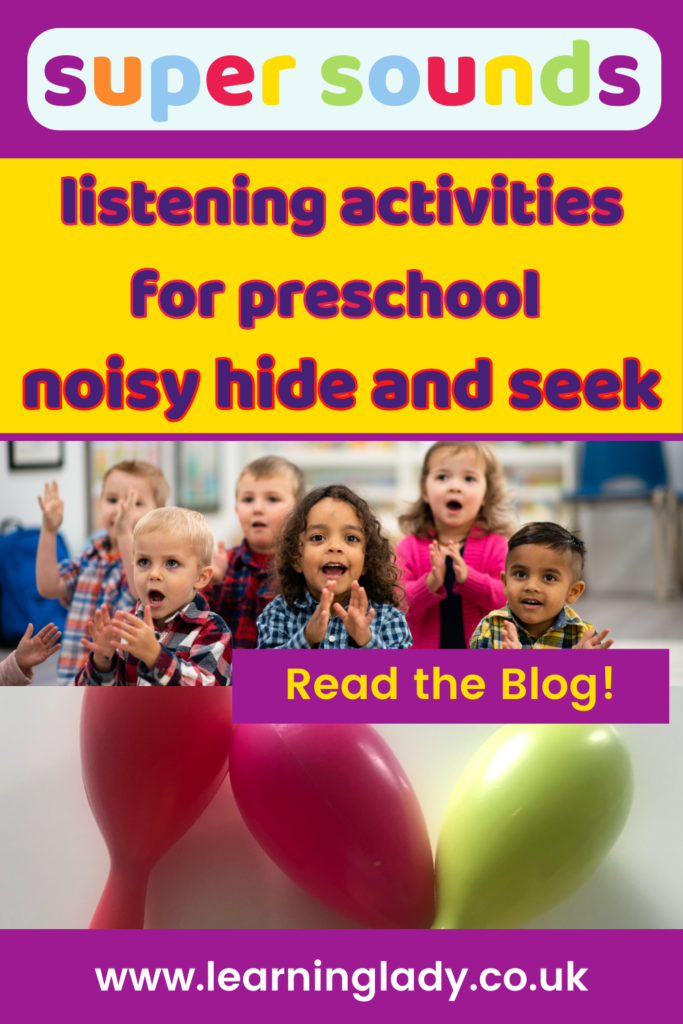
What you need:
Instruments or homemade sound makers (enough for 1 per child)
An object to hide and seek (for example a favourite toy)
A blindfold (optional)
How to play
Explain that the children are going to play a game of musical hide and seek, using the instruments to give clues.
Introduce the concept of playing the instruments to provide the clues by placing the object that will be hiding in the center of the space.
Encourage the children to play the musical instruments, becoming louder as you move nearer to the object.
The further away you move from the object, the children should play their instruments increasingly quietly. Practise this all together first.
Introduce the game using one of the children or a second adult as a model. They will need to hide their eyes, possibly using the blindfold.
Hide the chosen object so that the remaining children can see where the object is, without telling the blindfolded child / adult.
Remove the blindfold or ask the adult / child to uncover their eyes. This person is then tasked with finding the object using the musical clues provided by the remaining children, just like in a traditional game of hide and seek.
Guide the children to play the musical instruments more quietly as the adult / child moves further away from the object, more loudly as he / she is nearer to the object.
The aim of the game is to guide the adult / child to find the hidden object, playing the musical clues louder and more quietly all together.
Once the object has been found, repeat the activity with further children seeking the hidden object.
Listening activities for preschool |
The Traffic Light Game
This listening game for preschoolers is easy peasy to play and develops learning beyond just listening. The traffic lights in this game provide colour symbols for the children to match with sound making. A simple first step into developing prereading sound-symbol correspondences. |
Listening Activities for Preschool |
Which Instrument?
As our Nursery children grew in confidence and began to acquire more language, we were eager to build in listening activities to develop new words. This super simple musical game was a great way for staff to model words to describe sounds in different ways.
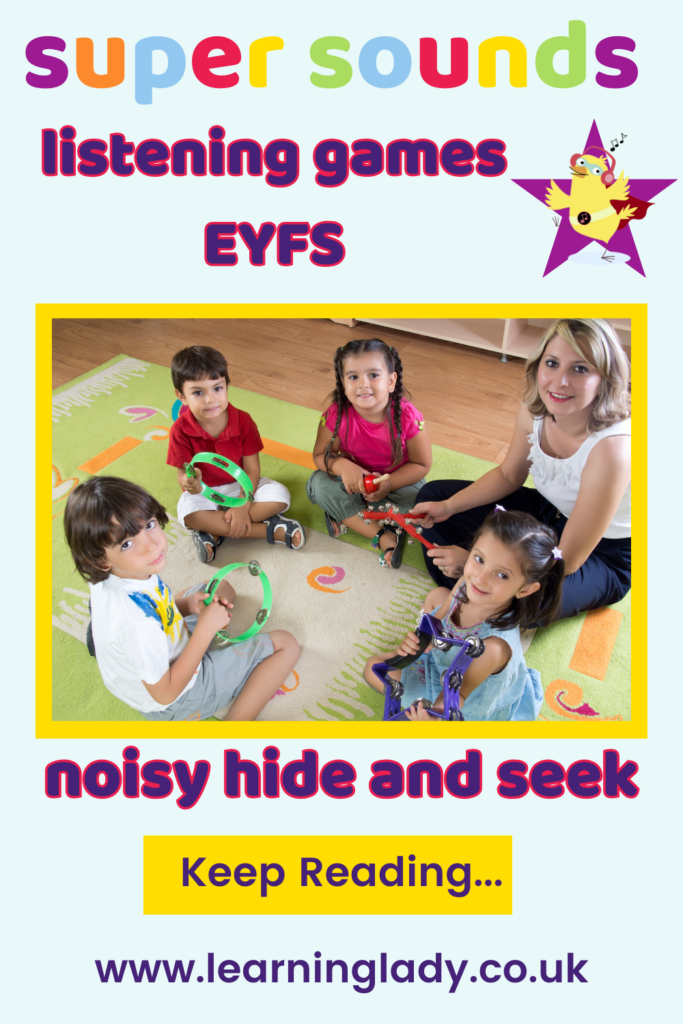
What you need:
Several instruments making different sounds. Create a barrier between you and the children. This needs to be large enough to hide and play the instruments behind. It could be a box, a ring binder, or a piece of card folded into a standing position.
|
Printed photos of each of the instruments. Place these in front of the children or stick them onto the outside of the barrier.
How to play:
Remind the children of the instrument sounds and names, saying these all together.
Explain that the children will be guessing which instrument is being played by listening for the musical clues.
Begin by introducing the song for the game.
“I’ve got sounds,1 (play instrument 1) and 2 (play instrument 2)”
Show the instruments as you play them.
“Hideaway.”
Hide both instruments behind the barrier.
“Listen now, listen now.”
“Which shall I play?”
Sing to the tune of Tommy Thumb
Play one of the instruments from behind the barrier. Can the children guess the instrument?
Encourage children who struggle to name the instrument by pointing to the matching picture.
Challenge children who guess which sound is being played to describe how they know.
For example:
“The triangle makes a tinging sound.”
“The bells make a jangling sound”.
Repeat several times then challenge more confident children to take the ‘teacher’ role, playing the instruments behind the barrier.
Listening Activities for Preschool |
Noisy Eggs
We initially introduced this to our listening activities for preschool at Easter time, and the children loved it! At first we were surprised at how challenging this was for some children, so starting off with fewer very different sounds is really helpful. |
Essential Listening Games EYFS Fun!
By the time our Nursery children went to school they were ready for reading because our initial listening games eyfs curriculum was so thorough. There was of course much more to perfectly prepared preschoolers than that, but the phase 1 phonics games we played from Super Sounds were the essential rocket fuel the children needed to get going! |
Easy listening game to play at home or nursery
Nursery Phonics Planning
If your preschooler enjoyed playing these preschool listening games and you want to continue the prephonics fun, then Super Sounds is just what you need
It’s an evidence-based, tried and tested prephonics programme that is designed specifically for 2,3 and 4 year olds.
Perfect for using before any phonics programme, Super Sounds is uniquely written for a fun and engaging approach to teaching a progression of prephonic skills step by step.
Whether you want fresh ideas as an alternative to Phase 1 Phonics, or you’re new to phonics in nursery and don’t know where to start, Super Sounds is waiting for you!
More Listening Games/Phase 1 Phonics Ideas
Super Sounds by The Learning Lady
Ready for Reading – Preschool Online Training Course
FREE Recommended Reading books for Preschool Phonics
5 Super Simple Phonics Games for Phase 1 Animal Sounds in Nursery
Looking for new preschool listening games? Guess the sound video
Super sun listening game | Ring Tone Challenge
Phase 1 Phonics Listening Fun | Who can you hear?
Listening game | phase 1 phonics | Noisy Christmas Presents
Phonics for nursery | Christmas Listening Fun
How to teach phonics to preschoolers for hours of fun
Fun preschool phonics game for 3 year olds
A closer look at phonics and prephonics, Tapestry podcast
More Phase 1 Phonics ideas on Pinterest
What comes before Phonics by Sally Neaum
